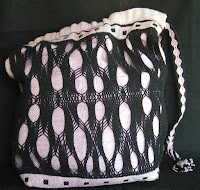 The 2008 challenge was called a "Conversation in Fiber", where we were to interpret the style or works of either Piet Mondrian or Georgia O'Keefe. I chose Mondrian, which presented the first challenge, since he worked only in primaries in his signature works, and the pallette was to include colors from the upcoming conference in Riverside, none of which were primaries. I decided to assign three of the conference colors to be "my" primaries. These were a red-violet as "red", a gold as "yellow", and a teal green as "blue". These are pretty close to an equally-spaced triad as primaries are, just "rotated" about 30 degrees on a color wheel. The little marks in my diagram each count an inch in my layout.
The 2008 challenge was called a "Conversation in Fiber", where we were to interpret the style or works of either Piet Mondrian or Georgia O'Keefe. I chose Mondrian, which presented the first challenge, since he worked only in primaries in his signature works, and the pallette was to include colors from the upcoming conference in Riverside, none of which were primaries. I decided to assign three of the conference colors to be "my" primaries. These were a red-violet as "red", a gold as "yellow", and a teal green as "blue". These are pretty close to an equally-spaced triad as primaries are, just "rotated" about 30 degrees on a color wheel. The little marks in my diagram each count an inch in my layout.rectangles, Mondrian style, and wove the colors in some of the rectangles by a "meet and part" sort of method where I exited the shuttles at a point in the center area of the warp. In a couple places, where there were more than one of the colors, I had 3 shuttles going up and down at various points...fun! This was one challenge where I did not end up with a handbag. I almost feel like I have to do this project again in miniature and sew it into a bag, just to have the collection complete. Here is the rug on display at our guild's November annual event.










